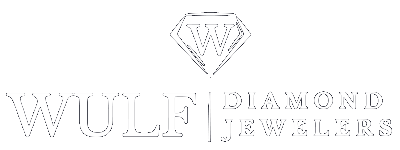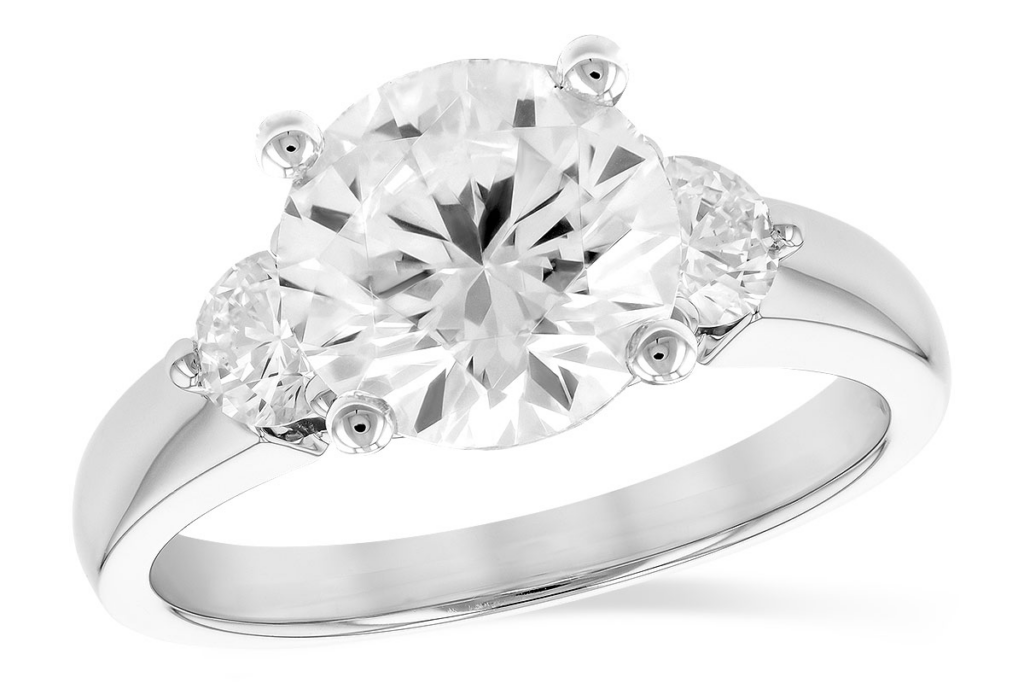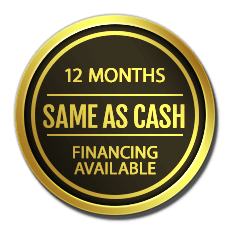There are lots of options and things to consider when buying a 1-carat diamond ring. However, the diamond engagement rings in this carat weight range between US$2,500-US$4,000. This price point is based on the most common engagement ring specifications:
| Diamond Cut | Round Brilliant |
| Diamond Type | Lab-Grown |
| Diamond Size | 6.5mm |
| Clarity | VS (Very Slightly Included; Inclusions not seen with the naked eye) |
| Color | GH (Near Colorless) |
| Metal Band | 14K White Gold Rhodium Plated |
| Setting | 6-Prong |
| Certification | Without Grading Report |
Did you know you can get an estimated cost of a 1-carat diamond ring with our online tool? Choose your mounting style, diamond cut, size, color, and clarity. You can also get a quotation if you want to get it engraved and get a matching band. Visit Wulf Diamond Engagement Ring Gallery or visit our customization tool.
Prices may go up or down when the quality of the diamond or band is changed. Diamond engagement ring can be anywhere between $2,000 to more than $10,000! Below, we will discuss what factors to consider when buying a diamond ring to get the most out of your budget.
How Much is a 1-Carat Diamond
Check how much is a 1-carat diamond using this online diamond calculator
How Diamond Type Affects Price
We have two different diamond types: Natural/Mined Diamonds and Synthetic/Lab-Grown /Lab-Created Diamonds. As discussed in our previous blogs about Diamonds and Diamond Simulants, both types are precisely the same.
When it comes to pricing, the rule of thumb is natural gemstones are more expensive than lab-grown. Diamonds are no exception.
And the price difference varies. The price difference between lab-grown and mined round-cut diamonds with the same VS clarity and GH color ranges from 50% to 70% per carat.
Thus in our example above, all else being equal, a 1-carat natural diamond engagement ring can cost you somewhere around US$10,000 – US$13,000.
How Cut and Shape Affects Price
Some diamond cuts and diamond shapes are more expensive than others.
But first, let us distinguish diamond cuts vs. shapes.
According to GIA, a diamond cut refers to a diamond’s “proportion, symmetry, and polish” and is usually assigned grades such as Excellent, Very Good, Good, Fair, and Poor. This grading is more common, with round brilliant cut diamonds being the most popular diamond cut in the market.
The diamond shape, on the other hand, is what most people refer to as diamond cuts. We have round, princess, oval, marquis, cushion, among others.
Certain diamond cut and shape are more expensive than others because:
- Some cuts are more common/popular than others, thus driving high demand
- Some cuts are more brilliant and disperse light better than others
- Some cuts require certain diamond clarity to make it eye-clean.
Let’s discuss each item.
More common/popular diamond cuts/shape
In the diamond market, round-cut diamonds account for 50% of the total available diamonds. This cut has a total of 57 to 58 facets which affect how light is reflected and refracted. Round cuts are also ideal because they make diamonds eye-clean – that is, inclusions are barely visible in the naked eye.
However, because of these features, round-cut diamonds are more expensive than their counterparts.
On the flip side, Asscher-cut diamonds are rare and are usually more expensive than all other cuts, even round-cut. A number of factors contribute to its expensive price point.
- While the regular has 57-58 facets, Royal Asscher cut has 74 facets. This means that more “diamond” is wasted to get this cut.
- It accounts for less than 5% of the market. Thus finding one with top grade and quality is difficult.
- It is easier to see inclusions on a step-cut diamond such as Asscher and emerald cut.

Some more affordable cuts are ovals, and princess cut diamonds. The price varies due to the demand for the cut or how little diamond was wasted during the faceting.
A 1-carat Oval Cut solitaire diamond ring, lab-grown with a grading report, Color FG with VS clarity, mounted in 14k white gold, is available for $3,500-$4,000. Price can go down significantly by choosing a lower clarity stone and opting for a lab-grown without grading report.
How Clarity Affects Price
The clarity refers to how “clear” a diamond is or the absence of any inclusions or flaws.
Diamond grading agencies describe diamond clarity using the following:
- FL – Flawless (clear, no inclusions)
- IF – Internally Flawless
- VVS1/VVS2 – Very Very Slightly Included (with inclusions but still eye-clean)
- VS1/VS2 – Very Slightly Included (with more crystal inclusions and visible under 10x magnification)
- SI1/SI2 – Slightly included (carbon inclusions are visible with the naked eye)
- I1/I2/I3 – Included (inclusions are visible and numerous)
The general rule is the clearer a diamond is, the rarer and more expensive it becomes.
In the above 1-carat diamond ring example, the clarity is set at VS1/VS2, usually the norm when getting an engagement ring with facet cut..
However, you can change the diamond to S1/S2 clarity and make it more affordable.
A 1-carat diamond ring, round cut, lab-grown without certification, S1/S2 clarity, and is set in 14k white gold will cost you somewhere between US$3,500 – $4,500
Quick tip: if opting for a lower clarity diamond, choose a diamond with a radiant cut vs. a step cut. Step cut makes inclusions more visible than radiant cut diamonds. This is why some emerald and Asscher cut diamonds are more expensive per carat weight than any other diamonds – it requires a diamond of higher clarity.
How Color Affects Price
The color of a diamond is one of the 4 C’s criteria and can significantly affect the cost of 1-carat diamonds. Natural and lab-grown diamonds’ color range from colorless (D) to yellow tint (Z). Any color yellower than Z grade is considered Fancy Diamonds (together with pinks and blues) and might be more expensive because of its rarity.
A 1-carat engagement ring set at 14k white fold with S1/S2 clarity, IJ color, lab-grown without grading report will cost you around $2,500-$3,000. Price will go up or down depending on the color of the diamond you choose.
Quick tip: Since diamonds reflect color, a colorless or near-colorless diamond will appear yellowish when paired with a gold metal band. Therefore, you can opt to buy a diamond with K-Z and pair it with a gold band.
Other Items to Consider
1-carat diamond rings are popular because they have the right balance between affordability and beauty. We discussed what can affect the cost of the ring, mainly by changing the 4C’s cut, color, and clarity.
However, there is still a lot of factors that can affect the price of a diamond ring.
Diamond Certification
A certified diamond ring, whether lab-grown or mined, is more expensive than diamonds without a grading report. Apart from the fee that they need to pay independent organizations (GIA, IGI, AGS), it guarantees the buyer that they are investing in a timeless piece.
Diamond certification also shows if a diamond is lab-grown or natural. It assures you that you are getting the most out of your money. Lab-grown diamonds, while beautiful and the same as natural diamonds, have lower to no resale value.
Size
Diamond size is different from carat weight. Carat weight refers to how heavy a diamond is (1 carat = 200mg), while diamond size refers to how big a diamond appears (measured in mm).
More than the size, what is being considered is the table surface. Table surface refers to the flat surface that bends light and bounces it to facets of the diamond.
While diamonds may have the same carat weight, the size may differ depending on the diamond cut. A round-cut, 1-carat diamond with perfect table to width and crown is 6.5 in mm.
Some cuts will appear larger while having the same carat weight. An example will be Marquise because of its elongated shape.
Band Settings and Additional Diamonds/Gemstones for 1-Carat Diamond Rings
Ring or diamond setting refers to how the diamond is held in place.
Solitaire diamond rings are popular and stood the test of time. However, an increasing trend of multi-stone and more intricate settings for diamond engagement rings arise.
There are a lot of setting styles in the market. It’s as many as people who want to customize their own. Here, we will discuss the most common setting styles that may increase the cost of your engagement ring.
read: Engagement Ring Settings: Choosing the Best Engagement and Wedding Ring Designs
Three-stone / Cluster Rings
As the name suggests, the three-stone engagement ring is where you add two additional stones on each side of your center stone. It is gaining popularity since you can opt for other more affordable precious and semi-precious stones to make it more appealing.
The three-stone engagement ring is said to symbolize past, present, and future.

Another variant of the multi-stone ring is the cluster setting. Instead of just putting two side stones, multiple smaller stones are added around the diamond.

Prong/Solitaire
There are many ring setting styles, but the most popular is the 4- or 6-prong or claw style. This setting style is popular because it maximizes the amount of light getting in the diamond, thus making the diamond more brilliant and sparkly to the eyes.

Tiffany
The Tiffany setting style is similar to the Prong style, where the diamond is mounted using prongs to allow as much light to hit the diamond as possible.
The difference between the regular Prong vs. Tiffany is very subtle. Unless you want a branded prong setting, you can choose either. These two almost look the same.
Pavé
Pavé setting is another type where diamonds are “paved” and placed side-by-side in your metal band. Having a Pavé setting increases the cost of your diamond ring because of the additional stones embedded in your metal band.

Channel
Channel is a setting style where diamonds are placed in a “channel.”
This type of setting is usually popular in wedding bands, but modern engagement rings also get this type of setting.

Channel setting will increase your 1-carat diamond ring value since more stones are added to the usual solitaire engagement ring.
Bezel
Popular in rings to hold the diamond securely in place, Bezel rings wrap the sides of the diamond completely.
Before Tiffany’s popularity, bezel-type mounting is used to hold the diamond in place.

A bezel setting can increase your 1-carat diamond ring value because of the additional metal used to secure the stone in place.
Halo
Halo-style is increasing in popularity because, in just a fraction of the price, it can make your 1-carat ring appear larger – optical illusion being your best friend. It also gives additional sparkle.

Halo style can increase the value of your ring because of the other smaller stones your surround the ring with.


Cathedral
Cathedral style is one of the settings popular in vintage rings but is slowly having a comeback.

Cathedral style is a setting where the diamond is placed on top of the ring’s shank (similar to prong style mounting) and is supported with a bearing underneath, and metals arch the side, similar to the metal columns found in cathedrals.
This style makes the ring more pronounced, especially when viewed from the side, and may make your 1-carat diamond ring appear larger.
Tension
As the name suggests, tension setting is a mounting style where the stone is “suspended” between 2 metals and is held in suspension. This makes the diamond appear floating.
While this design maximizes the amount of light absorbed and reflected by the diamond, this is more expensive because the metal should fit the diamond perfectly. Any miscalculation and you may be left with a missing diamond piece.
Band (Metal)
The type of band also affects the price of your 1-carat diamond engagement ring.
There are multiple kinds of metal to choose from. The most common metals used are Gold, Platinum, and in some cases, Silver. Some jewelers also started using other metals such as Titanium, Tungsten, and Cobalt.
Gold
The most popular of all is the 14K White Gold engagement ring. This meets the balance between affordability and durability. White gold is yellow gold but alloyed with white metals and is plated.
Other options available for gold are 10k, 18k, and 22k. Just note that the higher the karat, the softer and the more malleable the metal is.
On the flip side, the higher the karat, the more valuable it is, not to mention more hypoallergenic.
The key to the perfect karat is finding the balance between budget and lifestyle. While we all want to have the highest karat possible, it may not be ideal for persons with more active lifestyles or work requirements.
Another point to consider is getting a gold alloy that is hypoallergenic. While gold is regarded as a noble element and will not react to body chemicals, the alloys used to strengthen it might.

Just a reminder, when choosing white gold as your metal of choice, white gold will tarnish over time and will appear slightly yellow in appearance. Thus, there is a need to re-plate it to get it back to its white glory.
Platinum
Another metal to consider in engagement rings is Platinum.
Platinum is gaining popularity because of its naturally white color and its durability.

Unlike White gold, where there is a need to re-plate, Platinum will not tarnish. It is also more durable than silver or gold, perfect for those with active lifestyles, but is also malleable, which allows being resized if needed.
Platinum, just like gold, is hypoallergenic but is also alloyed with other chemicals. Thus, check with your jeweler the alloy used with Platinum if you are opting for this metal.
Silver
Another metal used for setting your 1-carat diamond engagement ring is silver.
Silver, just like gold, is a soft, malleable metal, but silver tends to tarnish, unlike gold. This characteristic makes it rather unpopular, especially if not plated.
However, gold-plated silver engagement rings are gaining popularity because of their affordable price point.
Other metals
Of course, you are not confined within those three metals mentioned. Other metals may be used to set your 1-carat diamond engagement ring.
Another metal gaining trend this 2021 is titanium.
Titanium rings are highly durable than other metals. However, because of its hardness, it is hard to do intricate designs. Resizing is also not an option for titanium rings.
Get the best 1-carat diamond ring!
We have discussed the cost of a 1-carat diamond ring and how you can change several attributes to make it less or more expensive.
The price of a ring can cost you somewhere between $2,500 – $10,000. Refer to our guide to help you decide on the type of diamond you want to buy.
Let Wulf help you buy the perfect 1-carat diamond ring. Visit our engagement ring gallery page or customize and get a quotation using our free online tool!



